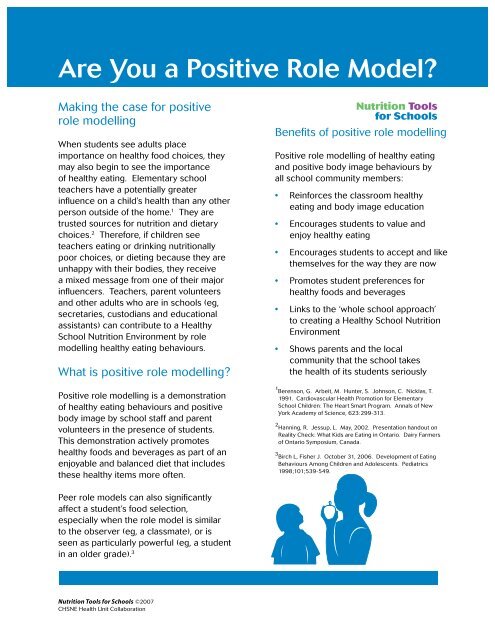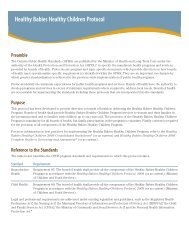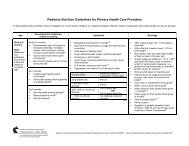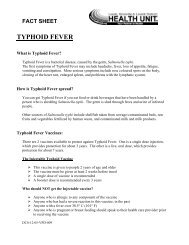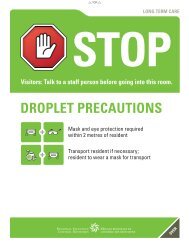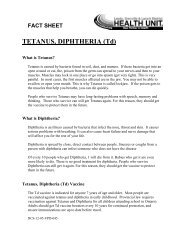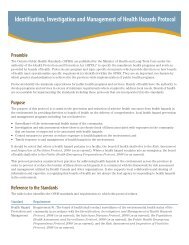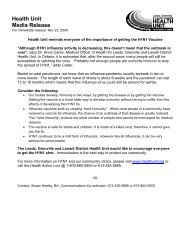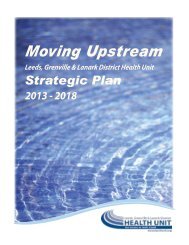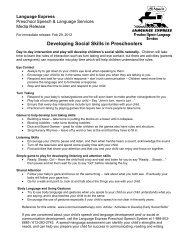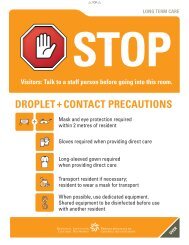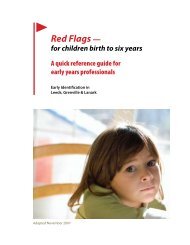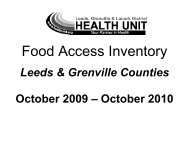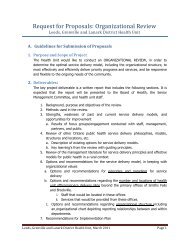Are You a Positive Role Model?
Are You a Positive Role Model?
Are You a Positive Role Model?
Create successful ePaper yourself
Turn your PDF publications into a flip-book with our unique Google optimized e-Paper software.
<strong>Are</strong> <strong>You</strong> a <strong>Positive</strong> <strong>Role</strong> <strong>Model</strong>?<br />
Making the case for positive<br />
role modelling<br />
When students see adults place<br />
importance on healthy food choices, they<br />
may also begin to see the importance<br />
of healthy eating. Elementary school<br />
teachers have a potentially greater<br />
influence on a child’s health than any other<br />
person outside of the home. 1 They are<br />
trusted sources for nutrition and dietary<br />
choices. 2 Therefore, if children see<br />
teachers eating or drinking nutritionally<br />
poor choices, or dieting because they are<br />
unhappy with their bodies, they receive<br />
a mixed message from one of their major<br />
influencers. Teachers, parent volunteers<br />
and other adults who are in schools (eg,<br />
secretaries, custodians and educational<br />
assistants) can contribute to a Healthy<br />
School Nutrition Environment by role<br />
modelling healthy eating behaviours.<br />
What is positive role modelling?<br />
<strong>Positive</strong> role modelling is a demonstration<br />
of healthy eating behaviours and positive<br />
body image by school staff and parent<br />
volunteers in the presence of students.<br />
This demonstration actively promotes<br />
healthy foods and beverages as part of an<br />
enjoyable and balanced diet that includes<br />
these healthy items more often.<br />
Benefits of positive role modelling<br />
<strong>Positive</strong> role modelling of healthy eating<br />
and positive body image behaviours by<br />
all school community members:<br />
•<br />
•<br />
•<br />
•<br />
•<br />
•<br />
Reinforces the classroom healthy<br />
eating and body image education<br />
Encourages students to value and<br />
enjoy healthy eating<br />
Encourages students to accept and like<br />
themselves for the way they are now<br />
Promotes student preferences for<br />
healthy foods and beverages<br />
Links to the ‘whole school approach’<br />
to creating a Healthy School Nutrition<br />
Environment<br />
Shows parents and the local<br />
community that the school takes<br />
the health of its students seriously<br />
1 Berenson, G. Arbeit, M. Hunter, S. Johnson, C. Nicklas, T.<br />
1991. Cardiovascular Health Promotion for Elementary<br />
School Children: The Heart Smart Program. Annals of New<br />
York Academy of Science, 623:299-313.<br />
2 Hanning, R. Jessup, L. May, 2002. Presentation handout on<br />
Reality Check: What Kids are Eating in Ontario. Dairy Farmers<br />
of Ontario Symposium, Canada.<br />
3 Birch L, Fisher J. October 31, 2006. Development of Eating<br />
Behaviours Among Children and Adolescents. Pediatrics<br />
1998;101;539-549.<br />
Peer role models can also significantly<br />
affect a student’s food selection,<br />
especially when the role model is similar<br />
to the observer (eg, a classmate), or is<br />
seen as particularly powerful (eg, a student<br />
in an older grade). 3<br />
Nutrition Tools for Schools ©2007<br />
CHSNE Health Unit Collaboration
What kind of role model are you?<br />
Success to share<br />
The parents at Holy Spirit Ukrainian<br />
Catholic Elementary School in Hamilton,<br />
Ontario began a student nutrition<br />
program to provide fruit and vegetable<br />
snacks for all students on a daily basis.<br />
One parent commented that she<br />
had continuously tried to introduce<br />
nectarines into her family home and into<br />
the kids’ lunches, yet it wasn’t until all<br />
students were sharing nectarines at the<br />
same time that her kids started to ask<br />
for this specific fruit on a consistent basis.<br />
The positive role modelling of healthy<br />
snacks at the school has introduced this<br />
family and all students to new and fun<br />
fruits and vegetables that can be found<br />
in their lunches more often.<br />
Submitted by Lesia Hucal, Public Health Dietitian,<br />
Hamilton Public Health Services<br />
What kind of role model are<br />
you?<br />
The following activities help school staff<br />
and parent volunteers to explore and<br />
recognize ways that they can inhibit or<br />
promote healthy eating behaviours and<br />
positive body image among students.<br />
Answer the questions on your own.<br />
The soul-searching questions in activity<br />
one and activity two have no right<br />
or wrong answers. Exploring your<br />
responses will offer valuable insight into<br />
how you may be influencing children’s<br />
beliefs about healthy eating and healthy<br />
body image.<br />
Activity One: What kind of role<br />
model are you with respect to<br />
healthy eating?<br />
•<br />
•<br />
•<br />
•<br />
•<br />
•<br />
•<br />
•<br />
•<br />
•<br />
•<br />
Do you teach your students about<br />
the importance of eating a healthy<br />
breakfast, but skip breakfast yourself<br />
and sip on coffee throughout the<br />
morning?<br />
Do students see you eating nutritious<br />
foods?<br />
Do you eat or drink unhealthy choices<br />
when teaching?<br />
Do students see you drink milk or<br />
water instead of pop/coffee?<br />
Do you eat school meals? Drop by<br />
the breakfast program to chat with<br />
students?<br />
Do you encourage your students to<br />
bring in healthy snacks, but snack<br />
on doughnuts in the staff room?<br />
If you notice a student is hungry or<br />
comes to school without breakfast,<br />
do you refer him or her to the<br />
breakfast or snack program?<br />
Do you treat children who attend<br />
the breakfast or snack program<br />
differently?<br />
Do you share your food likes and<br />
dislikes (eg, not eating meat, only<br />
eating organic foods)?<br />
Do you reward students with<br />
non-food rewards such as stickers,<br />
erasers or pencils?<br />
How do you support your school’s<br />
attempts to create a Healthy School<br />
Nutrition Environment?<br />
Nutrition Tools for Schools ©2007<br />
CHSNE Health Unit Collaboration
What kind of role model are you?<br />
Activity Two: What kind of role<br />
model are you with respect to<br />
body image and self-esteem?<br />
•<br />
•<br />
•<br />
•<br />
Have you inadvertently promoted<br />
a fear of being fat by your words<br />
and actions?<br />
<strong>Are</strong> your perceptions of body weight<br />
issues a barrier to teaching nutrition<br />
education?<br />
Do you refrain from talking about<br />
dieting in front of students?<br />
Do you comment on how you look<br />
or how much you weigh?<br />
When children hear adults expressing<br />
dissatisfaction with their bodies, they may<br />
begin to believe that being an adult means<br />
being unhappy or concerned with one’s<br />
body. When they hear adults criticizing<br />
or admiring the bodies of others, they<br />
may copy this behaviour by teasing other<br />
children about their bodies. <strong>You</strong> can<br />
support your students in accepting and<br />
loving their bodies, even when you aren’t<br />
teaching nutrition!<br />
•<br />
•<br />
•<br />
Am I dissatisfied with my body size<br />
and shape?<br />
Do I talk about my unhappiness with<br />
my body? Whom do I talk to and who<br />
might overhear what I have to say?<br />
Am I always going on a diet or coming<br />
off a diet? Who knows when I’m on<br />
a diet and how do they know?<br />
•<br />
•<br />
•<br />
•<br />
Do I feel guilty when I eat certain<br />
foods? Do I refuse to eat certain foods<br />
while commenting that I am dieting<br />
to lose weight? Do I emphasize ‘bad’<br />
foods versus ‘good’ foods?<br />
Why do I think children or adults<br />
become overweight?<br />
What do I think when I see an<br />
overweight child or adult? Do I tend<br />
to pay less attention to overweight<br />
children in my classroom? Do I give<br />
overweight parents the same amount<br />
of time and attention as I do parents<br />
who are not overweight?<br />
How do I intervene when I observe<br />
teasing of an overweight child by<br />
other children?<br />
• Have I ever been surprised when<br />
an overweight child, who I thought<br />
was not very bright, got a high grade<br />
on a standardized test? Has a parent<br />
ever complained that I was treating an<br />
overweight child unfairly in some way?<br />
Adapted from ‘Am I Fat? Helping <strong>You</strong>ng Children Accept<br />
Differences in Body Size’ Joanne Ikeda, Priscilla Naworski,<br />
ETR Associates, 1992.<br />
If you are concerned about some of your<br />
answers to the above questions, contact<br />
your local public health unit/department<br />
to speak to a health professional who is<br />
knowledgeable about healthy eating,<br />
body image and self-esteem issues.<br />
Nutrition Tools for Schools ©2007<br />
CHSNE Health Unit Collaboration
Does your school have a Healthy<br />
School Nutrition Environment?<br />
A Healthy School Nutrition Environment exists when a school promotes healthy eating through<br />
words and actions. Students get the same message about food, nutrition and healthy eating<br />
wherever food is served – in the classroom, in the school and at home. The following nine<br />
Essential Elements 1 are recommended for a school to have a healthy nutrition environment.<br />
Whole School<br />
Approach<br />
In the School<br />
Essential Elements<br />
Does your school offer healthy, reasonably priced and culturally-appropriate food<br />
choices? For example does your school have:<br />
• healthy fundraising?<br />
• a school milk program?<br />
• a healthy tuck shop?<br />
• healthy ‘special food’ days?<br />
• non-food rewards in the classroom?<br />
• healthy classroom celebrations?<br />
• healthy refreshments at school meetings and events?<br />
Do parents, teachers and volunteers role model healthy eating and body image<br />
behaviours at school?<br />
Does your school have a Student Nutrition Program (eg, breakfast, snack and<br />
lunch)?<br />
Does your school practise safe food practices and have an allergy-safe<br />
environment?<br />
<strong>Are</strong> nutrition breaks at school appropriately scheduled?<br />
Does your school have a food and nutrition policy?<br />
In the Classroom<br />
Do teachers participate in professional development on nutrition?<br />
Do teachers have up-to-date nutrition resources to support the healthy eating<br />
expectations in the curriculum?<br />
In Homes and<br />
In the Community<br />
Does your school provide student, parent and community education about<br />
healthy eating?<br />
1 Ontario Society of Nutrition Professionals in Public Health School Nutrition Workgroup. 2004 Call to Action: Creating a Healthy School<br />
Nutrition Environment.<br />
Nutrition Tools for Schools ©2007<br />
CHSNE Health Unit Collaboration
Need more information?<br />
Public health offers Nutrition Tools for Schools - a toolkit for elementary schools. Whether<br />
you’re a teacher, parent, school administrator or volunteer, this toolkit will lead you through<br />
a step-by-step process to creating a healthy nutrition environment in your school. Nutrition<br />
Tools for Schools contains a variety of resources and tools to implement the nine Essential<br />
Elements listed above. For more information about this toolkit, please contact your public<br />
health unit/department.<br />
This Fact Sheet is distributed by:<br />
For More Information, Call the Health ACTION Line<br />
1-800-660-5853 or 613-345-5685<br />
or visit our website at www.healthunit.org<br />
Nutrition Tools for Schools ©2007<br />
CHSNE Health Unit Collaboration 14


